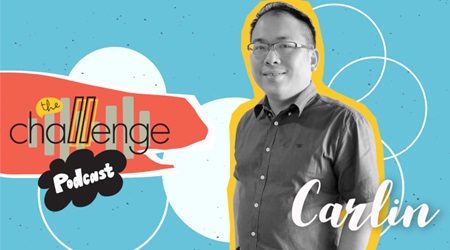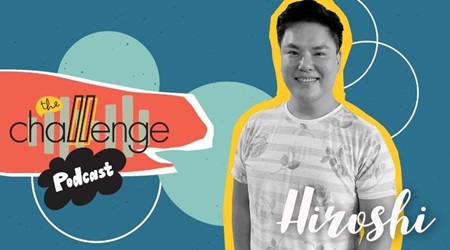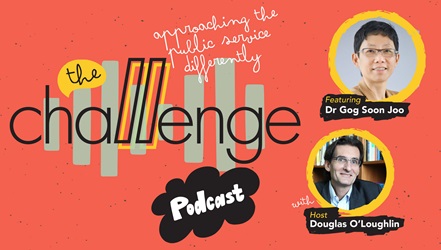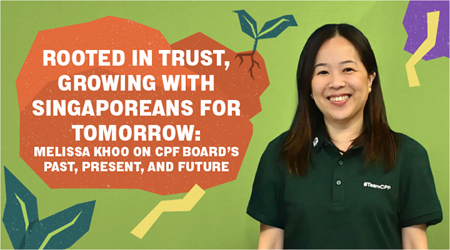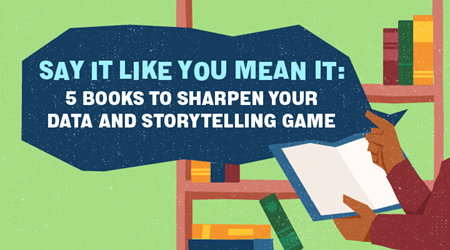Mindline.SG and the Road To De-stigmatising Mental Health Issues
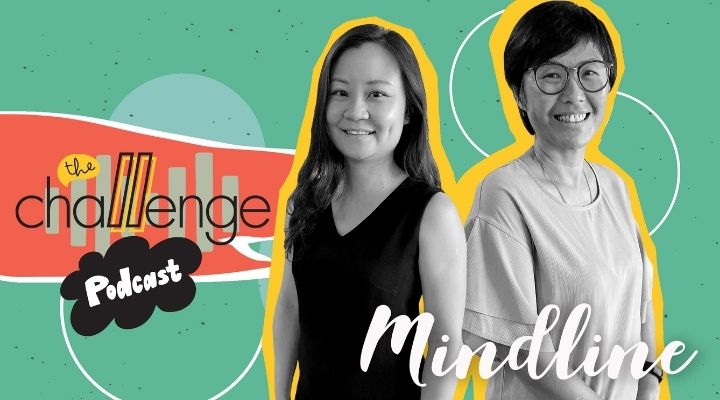
The COVID-19 pandemic has brought mental health issues to the fore. For this season of The Challenge Podcast, we kick things off with a chat with two officers involved in the development of an online mental health resource that seeks to go beyond just dealing with stresses from COVID-19. Transcripts have been edited for clarity and language.
Transcript
Host: Douglas O’Loughlin
Audio: Fei
Douglas: Hello and welcome to the Challenge Podcast where we discuss all things public service in Singapore. I'm your host, Douglas O'Loughlin, an organisation development consultant and a former public officer.
This season of the podcast is focusing on wellbeing. We are starting the discussion with a chat with two public officers from the Ministry of Health’s Office for Healthcare Transformation or MOHT. They are Dr Tan Weng Mooi, who’s Director and Co-Head of Integrated Health Promotion, and Ms Janice Weng, who’s a Senior Assistant Director from the same division.
So, welcome to our podcast, Weng Mooi and Janice! Thank you so much for being a part of it. How are you doing today? (In Mandarin) Have you eaten yet?
Weng Mooi: (In Mandarin) Yes I have.
Janice: Yes, had a good lunch.
Douglas: Now, you may wonder why we opened with that question. Well, we're checking in to see how we're doing. So ‘are you okay?’ would be another way to say that. But thank you so much for being here.
So could you tell us more about what you do at MOHT?
Weng Mooi: MOHT stands for Ministry of Health Office for Healthcare Transformation. We are a unit that was set up by MOH about three years ago to look into how we can partner various stakeholders to transform healthcare, and angle it on three fundamentals. One of these is how to use data to help drive better decision-making. Secondly, to see how we can empower our people and partners to be able to make better decisions and perhaps be more efficient and effective in using digital solutions. And the third part is, very importantly, to see how we can make the healthcare system provide what we call value-based healthcare, making sure care is appropriate and cost-effective. So those are the three fundamentals.
Janice and I belong to a unit called InHealth, which stands for Integrated Health Promotion. We look into how we can work with the community, promote a healthy lifestyle and understand what it takes for people to lead a healthy lifestyle.
Janice: Yes, as part of InHealth, one of the key thrusts that we have is to look at building mental wellness and resilience in the population. And one of the first initiatives that we developed was mindline.sg. It is a one-stop wellness platform to get people to increase their knowledge of what self-care means for them, get access to the resources that are out there and be connected to different resource providers if and when necessary.
Douglas: Your work sounds very complex. How do you all take care of each other? How do you make sure you are ready to take on such challenging work?
Janice: I think we have a very caring environment at MOHT. The leaders take it upon themselves to check in with each other and their employees. We would also have lunch regularly over Zoom, especially during the past year. We would play games and I think we started a buddy system as well where once a week, we would check in on one another and ask ‘are you ok?’, ‘how are you feeling?’, ‘is there something we need to do to support you?’. So these were some of the initiatives we started.
Weng Mooi: I must add it started with our ED (Executive Director) Professor Tan Chorh Chuan. He is very caring, a visionary and speaks with a lot of respect. And in fact, when we started going back to the office, the first thing he did was to buy us some chocolates and snacks.
So I think, yes, the leaders and of course individuals reminding each other. We have a weekly meeting among our in-house team. Sometimes I get very intense in the meeting, chasing deadlines and things. And our interns said, look, maybe we should have a five-minute exercise. So we started to build in an exercise in our meetings so people learn to take a break and take a step back. Janice, maybe you could share your experience with yoga? You know, she specialises in yoga and went all the way to India and I was so impressed.
Janice: Yes, pre-pandemic I did some sessions for my own InHealth teammates. It's my passion and I think it's important to exercise self-care and lead by example in the work that we do.
Douglas: Wow! And those are very practical practices that that any organisation can work on. So back to mindline.sg. You mentioned it is a really fun platform to play in. But there are other platforms out there, so what makes this different? Who can access it?
Janice: So we came together with a few key ecosystem partners during the first “Circuit Breaker” period in April 2020. We got together with IMH (Institute of Mental Health), MSF (Ministry of Social and Family Development), and NCSS (National Council of Social Service) – a few of the key players who were already looking into the mental wellbeing space.
We were starting to hear of different heightened stress levels. There were the dorms where many people had been infected with COVID-19. There were cases of people inflicting self-harm, and the workers were generally worried about the situation in their home countries as well.
Then you had parents feeling stressed because during that period, schools were closed, which meant additional caregiving responsibilities. We were also hearing of increased incidents of domestic violence. So due to these multiple social health issues, a few of the key agencies came together to co-create mindline.sg, and we launched it in June 2020.
So anyone with a mobile phone or an Internet connection can get on board: type in ‘mindline.sg’ into the browser and get access to the full range of resources there. And I think one of the key differentiators of mindline.sg as opposed to other platforms or apps is that we took a kind of strong government approach to it. Our team of psychiatrists, psychologists, and social workers validated the resources that were made available. So for everything we put in there, we made sure there is some literature around it. It’s something people can trust, use or access.
I think secondly, because it's led by MOHT, we have the ability to look at it as a public good. So the resources in there – including the ability to chat with the Wysa AI chatbot – all these are freely available to anyone.
Weng Mooi: If I may add on, I think one of the key differentiators is the fact that the team has built in there (mindline.sg) not just those resources, but also assessments for one’s own mental health status. And we use evidence based clinical assessment tools like PHQ-9 (Patient Health Questionnaire-9) and GAD (General Anxiety Disorder) for two common mental illnesses that people will face: anxiety and depression.
And after the assessment, you would be pointed to keep doing what you are doing – like reading and relaxation – if you are fine, or to link you to the help you should seek if it is required. There would be a list of where you can get this help. For example, some of this could be provided by social service agencies free of charge, or in other specific situations, you could perhaps go to a hospital.
Douglas: For listeners hearing about this for the first time, what kind of advice would you give them – when should they go into mindline.sg or how often? How can they use it optimally?
Janice: When we conceptualised mindline.sg, we saw it as something to build good mental health. So you know, traditionally, when people think about mental health, they might think about mental illness, they might think about schizophrenia. When we started this project, we really wanted to de-stigmatise what mental health means. We wanted it to be about self-care, about empowering people to take mental health into their own hands and be able to keep well for as long as they can.
So with this as the key principle, what we do is encourage people to go on mindline.sg to do a mental health check every six months to a year, engage in self-care activities like meditation, or speak to the Wysa AI chat to share their emotions whenever necessary. For example, you might go into the office and your boss starts asking why you have not done something or why you have not met a deadline. These are times when I think someone can go into mindline.sg and access some of the resources there to help them reframe their thoughts, and be on a more emotionally stable path.
Douglas: Okay, that sounds good. You use the terms “mental health”, “mental wellness”, and some people lump in “resilience”. Could you deconstruct these a bit? How do you like to talk about them? They get used interchangeably when I think they're quite different.
Weng Mooi: So we usually think that mental health equals to mental illness and consequently people’s behavioural problem. But the WHO’s (World Health Organization) definition of mental health relates to people who can function, people who are able to live on a daily basis of doing the work and enjoying the things that they do. It's not just about the absence of illnesses.
When you're talking about mental resilience, it refers to how our body or mind is able to bounce back and take this kind of stress that might sometimes be overwhelming.
When we are talking about people with mental disorders such as depression, they have to go through a list of criteria based on what I call the bible of the psychiatrists, the Diagnostic Service Manual (DSM). It is used to match the signs and symptoms with the criteria for each disorder. So some people match some parts, but not completely. They are called subclinical.
But you know, we often don't see it that way. We just say mental health equals to a mental disorder. So this, I think, is a bit of a misnomer. And personally, I think it sometimes creates stigma as well because people don't understand.
Douglas: You know, I had a sister who was diagnosed as bipolar under DSM and unfortunately now a niece as well. So when you hear things like mental illness, I mean, that's serious stuff. Just because somebody is a bit overwhelmed at work, I don't think we should stigmatise them and get those terms confused.
Weng Mooi: Absolutely. In fact for most of us who are mental health professionals, we usually like to use the word mental health issues, because there are minor ones when you are distressed. Sometimes you may feel a bit anxious, but that doesn't mean you have anxiety. To say you have anxiety requires time to determine whether or not you are able to function or even leave your home.
Douglas: So if we could come back to this, and let's say somebody is listening to us and wants to check a little bit on their mental health – where do you think they should go in the app? You mentioned it before, but maybe you could give some specific directions on how to navigate it?
Janice: When a user goes into mindline.sg, there are two pathways they can take. One is mindline.sg. It provides resources for the self, depending on the full range of life challenges they might face. For example, if you lose your job or have caregiving stress, that's probably the pathway to take to explore the site.
The other product we have is called mindline at work. So specifically, mindline at work addresses workplace stresses. And I think this might be something suitable for all our public officers to try out. They can assess their own state of mental wellbeing by using the self-assessment tool Weng Mooi spoke about earlier. From there, there are different protocols, as we call them, a user might be routed to. And based off the protocol they are routed to, there are different types of recommendations that would be provided to them.
So for example, for someone who is referred to the “well” pathway, there will be a full range of self-care exercises, like gardening, speaking to Wysa, or doing some meditation exercises to keep well. If someone were routed to a “moderate”, or a “crisis” path, there would be different types of social service organisations or IMH hotline that they would be recommended to call. And that’s because in these cases, it is necessary for them to speak to an actual therapist or counsellor to get the help they need.
Douglas: So how do you see this working, not just for individuals, but if you look at agencies and ministries – how do you see it really impacting the larger system?
Janice: When we conceptualised this within MOHT and proposed to do something for working adults, I think DS Zsin Woon (former Deputy Secretary, Public Service Division or PSD) said, okay, you know, PSD is willing to partner you on this journey. And I think together with the partnership with PSD, we did focus group discussions with a lot of public officers. We wanted to understand some of the key stresses they might face at the workplace, and some of the resources other agencies provide. We wanted to know how this full suite of programmes and services could come together to support public officers.
So with that, mindline at work was born. And interestingly one of the things they said was, you know, mindline.sg is pretty serious with discussions on mental health. I want mindline at work to be something fun that uses casual terms. Personal effectiveness affects us, right? So how do we also have conversations with our bosses if they are the ones who are causing us stress?
So we got a comic illustrator to work with us to design a series of comics that illustrate different work situations, stressful work situations, in a fun way that users could relate to and secretly share with their bosses to start conversations.
Weng Mooi: I think there are a couple of things when you talk about work. For example, work stress starts with us. So what mindline at work wants to do is to test your mood and from there, help you figure out your concerns. So for someone new, the first 100 days at work could bring about some anxiety. For instance, how do I deal with my supervisor? So there are things tailored for the individual to deal with these issues.
Then there are the supervisors, especially new supervisors. How do I foster teamwork? How do I get my people to understand why we are chasing deadlines? So they are tailored towards the different people within the workplace.
And of course, beyond ourselves is our work environment and work culture. So mindline at work also tries to address this. For example, how do you work in a place that has a toxic work culture?
Douglas: Imagine teams or divisions of people coming together, and the leader or someone else picks one of the little quizzes for everyone to do and compare how they turned out – as a way to learn about and understand each other better. Wouldn’t it be nice?
Janice: Yes, like challenges where you can get different teams to participate in different activities and gain points. And a form of competition, maybe between different divisions, to see who did the most meditation exercise or learnt the most about a particular topic at work. I think that's definitely something we are trying to work towards with organisations: how do we work with the HR professionals within the organisations? How do we work with the leaders? How do we work with new joiners to see how, as a whole, we can build that culture within the organisation to value wellbeing?
Weng Mooi: When you build a culture, it starts with the person, the leaders, and as well as how to engage with each other. We are humans, and humans need social interactions, communication, and engagement – part of something I call the 3 Es. And mindline at work can be one of the tools you use while you're engaging your people. There are resources there and you can even do little quizzes.
The second part is empowerment. It is about how you provide training and give people the right tools to take care of their own mental wellbeing. Mindline at work can provide them little activities like breathing exercises and, depending on their mood, things that are tailored for them individually.
And the third E is really about enablement. So you may have an HR that is very participative and promoting a lot of that. And I know, for example, in the Public Service there is a wellness ambassador. So how do you get these people to be able to also increase their knowledge by using mindline at work?
Douglas: This is wonderful. For all you listeners out there, if you have not done this yet, please go into mindline.sg and play with it. See what resources are available and share them with your team if you think some of them are useful.
One last question on this: you've been at this for about a year and a half. I think every day you're thinking about how to enhance it and make it better. So could you describe your aspirations for what it would be for our country or society and everyone in Singapore?
Janice: When we started out this journey, we wanted to have a very non-ambitious goal. We just wanted to provide people with resources to tide them through the pandemic, which we know is a very stressful situation. But as we got on this journey and understood a lot more about the potential of digital platforms and digital tools, we started to realise there's a lot of things we could do to build wellbeing in a population using something as simple as a web app.
And I think there is potential to go deeper into meeting the needs of different target segments. So for example, we started out with mindline at work, which targets working adults. The next thing we are looking to go towards is to build a platform specific to younger population groups – students, teenagers, and adolescents. Their needs could be quite different. They are all into TikTok and different types of social media platforms. So how can we work with them to co-create something that could meet their needs?
Weng Mooi: The other part I think, with a lot of feedback, I think maybe Janice can elaborate a bit more, is that people find chatting with the AI chatbot “not human”. People like to be able to talk to humans. So I think one of the things we are trying to do is create a seamless connection to a human counsellor, a web chat, or something in the form of a digital letter.
Janice: There are many interesting ways that globally, they have tried to reach out to particularly the younger group, which values anonymity, but also that group connection. So things like online group therapy, or the ability to chat anonymously with a trained volunteer or with a peer, since they might only like to talk to people of the same age group.
So I think these are some of the different things we're thinking of introducing to the mindline platform, to get people comfortable with the concept. It's okay to talk to someone about your issues. It’s not something to be ashamed about. There are resources and help out there to tide you through any issues you might face.
Douglas: It's okay not to be okay. Yes, sorry to use that line.
Weng Mooi: Absolutely, and one of the things we are hoping to do is to perhaps work with professional groups and use mindline.sg or in future, mindline youth, or mindline at work as a supplementary tool. You can only see a therapist once or twice a week. You can’t be seeing them 24/7. Mindline.sg on the other hand is like a little companion for you: 24/7 free of charge, anytime, and in a safe space. And then, you can give feedback to your therapist on how you feel and things like that.
Of course, ideally, we have them all interconnected. It’s like the whole integrated digital system from using mindline.sg and maybe one day even – you know, people wearing all these electronic things like me – using digital phenotyping that can capture data on sleep, heart rates, etc, and from there it could link to mindline.sg. Further on, it could connect to your counsellors, therapists and maybe your GPs, your doctors at the hospital, and parents and caregivers as well. After all, we are in a very interconnected world.
Douglas: It sounds like you're going be very busy with this. So please take care of yourself as well. You probably use the app to support yourselves along the way, to be congruent here and test it out.
Thank you so much Janice and Weng Mooi for being here, sharing all your experiences and updating all of us about this wonderful resource that we have, mindline.sg.
Thank you for listening to this podcast. I’m your host Douglas O’Loughlin. Follow us for new episodes, and follow psd.gov.sg/challenge for more public service stories.

To hear more conversations like this, follow the Challenge Podcast on Spotify.
- POSTED ON
Dec 2, 2021
- TEXT BY
Keval Singh
-
Season 2: Mental Wellbeing
Employee Wellbeing And Self-Care
-
Season 2: Mental Wellbeing
Centring Yourself Through Mindfulness
-
Season 2: Mental Wellbeing
The Case for Employee Wellbeing





